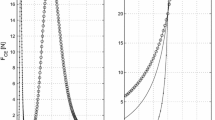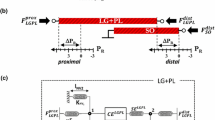Summary
Models are useful when studying how architectural and physiological properties of muscle-tendon complexes are related to function, because they allow for the simulation of the behaviour of such complexes during natural movements. In the construction of these models, evaluation of their accuracy is an important step. In the present study, a model was constructed to calculate the isometric force-length relationship of the rat extensor digitorum longus muscle-tendon complex. The model is based on the assumption that a muscle-tendon complex is a collection of independent units, each consisting of a muscle fibre in series with a tendon fibre. By intention, values for model parameters were derived indirectly, using only the measured maximal isometric tetanic force, the distance between origin and insertion at which it occurred (optimum l OI ) and an estimate of muscle fibre optimal length. The accuracy of the calculated force-length relationship was subsequently evaluated by comparing it to the relationship measured in isometric tetanic contractions of a real complex in the rat. When the length of distal muscle fibres, measured during isometric contraction at optimal l OI of the whole complex, was used as an estimate for muscle fibre optimal length of all muscle fibre — tendon fibre units in the model, the calculated relationship was too narrow. That is, both on the ascending limb and on the descending limb the calculated tetanic force was lower than the measured tetanic force. These discrepancies could be explained partly by assuming that a spread existed in optimal lengths of the units, and that the units which contained the distal muscle fibres were acting below their optimal length during isometric contraction at optimal l OI of the whole complex.
Similar content being viewed by others
References
Bobbert MF, Van Ingen Schenau GJ (1990) Isokinetic plantar flexion: experimental results and model calculations. J Biomech 23:105–119
Bobbert MF, Brand C, De Haan A, Huijing PA, Van Ingen Schenau GJ, Rijnsburger WH, Woittiez RD (1986a) Series elasticity of tendinous structures of rat EDL. J Physiol (Lond) 377:89P
Bobbert MF, Huijing PA, Van Ingen Schenau GJ (1986b) A model of the human triceps surae muscle-tendon complex applied to jumping. J Biomech 19:887–898
Ettema GJC, Huijing PA (1989) Properties of the tendinous structures and series elastic component of EDL muscle-tendon complexes of the rat. J Biomech 22:1209–1215
Gordon AM, Huxley AF, Julian FJ (1966) The variation in isometric tension with sarcomere length in vertebrate muscle fibers. J Physiol (Lond) 184:170–192
Huijing PA (1985) Architecture of the human gastrocnemius muscle and some functional consequences. Acta Anat 123:101–107
Huijing PA (1988) Determinants of length range of active force exertion. In: Harris G, Walker C (eds) Proceedings of the Annual Conference of IEEE Engineering in Medicine and Biology Society, vol 10, part 4, Publishing Service IEEE, New York, pp 1665–1666
ter Keurs HEDJ, Iwazumi T, Pollack GH (1978) The sarcomere length-tension relationship in skeletal muscle. J Gen Physiol 72:574–592
ter Keurs HEJD, Luff AR, Luff SE (1981) The relationship of force to sarcomere length and filament lengths of rat extensor digitorum muscle. J Physiol (Lond) 317:24P
Otten E (1988) Concepts and models of functional architecture in skeletal muscle. Exerc Sports Sci Rev 16:89–137
Stephens JA, Reinking RM, Stuart DS (1975) The motor units of cat medial gastrocnemius: electrical and mechanical properties as a function of muscle length. J Morphol 146:495–512
Stephenson DG, Stewart AW, Wilson GJ (1989) Dissociation of force from myofibrillar MgATPase and stiffness at short sarcomere lengths in rat and toad skeletal muscle. J Physiol (Lond) 410:351–366
Walker SM, Schrodt GR (1974) I segment length and thin filament periods in skeletal muscle fibers of the rhesus monkey and the human. Anat Rec 178:63–82
Woittiez RD, Huijing PA, Boom HBK, Rozendal RH (1984) A three dimensional muscle model: a quantified relation between form and function of skeletal muscles. J Morphol 182:95–113
Woittiez RD, Brand C, De Haan A, Hollander AP, Huijing PA, Van der Tak R, Rijnsburger WH (1987) A multipurpose muscle ergometer. J Biomech 20:215–218
Author information
Authors and Affiliations
Rights and permissions
About this article
Cite this article
Bobbert, M.F., Ettema, G.C. & Huijing, P.A. The force-length relationship of a muscle-tendon complex: experimental results and model calculations. Eur J Appl Physiol 61, 323–329 (1990). https://doi.org/10.1007/BF00357621
Accepted:
Issue Date:
DOI: https://doi.org/10.1007/BF00357621




